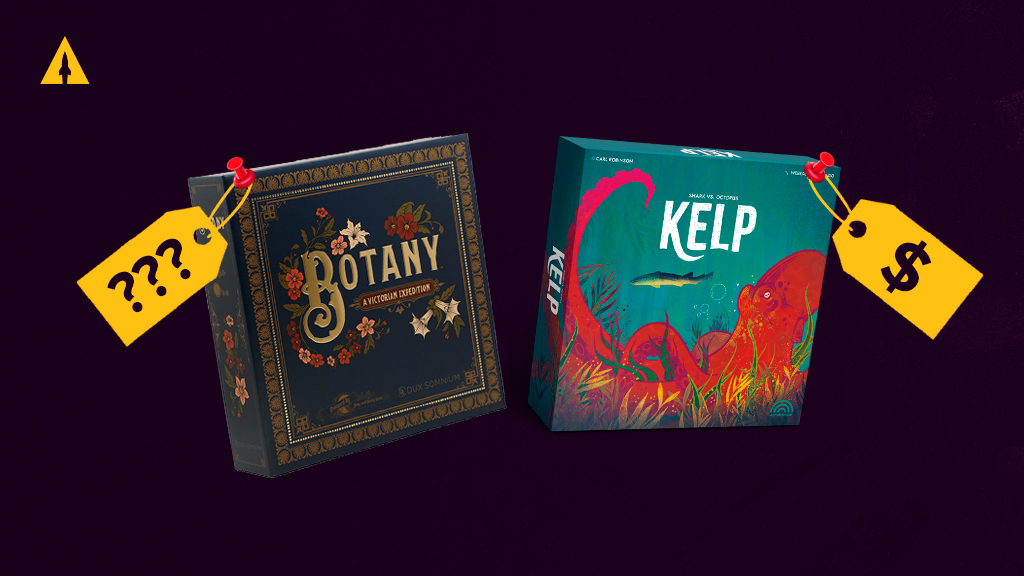
If you’re into tabletop games, you might have battled monsters in Gloomhaven. Or led a vicious, post-war faction in Scythe’s alternate-history 1920s. Or survived a spaceship infested with lifeforms in Nemesis.
What do all three of these games have in common? Besides immersive storytelling, replayability, and long lists of accolades, there’s one final thing — all of them were launched through crowdfunding.
If you’re thinking of crowdfunding your board game, you might be wondering:
- How much does it cost to publish a board game?
- Is a board game expensive to make?
- What’s the best crowdfunding platform for my game?
Let’s talk through the process of publishing a board game and what costs to expect at each step.
Contents
What is board game publishing?
If you’re trying to break into the games industry, there are two major routes you can take.
One, partner with a traditional board game publisher. Major board game publishers like Hasbro, EuroGames, or Asmodee handle the bulk of the legwork and pay you 5-8% royalties on wholesale price. The challenge is, you’re one in a pile of submissions. You could pitch to publisher after publisher, and your fate is ultimately in the hands of a few gatekeepers.
Or two, you can self-publish. You build your own business, brand, and community. You retain total control over the product and creative vision from start to finish.
More and more game creators are choosing the self-publishing route. And those games are ending up on platforms like Kickstarter. In fact, $1 per every $3 raised on Kickstarter comes from the Games industry. There are over 44,000 games currently on Kickstarter.
If you self-publish, you’re fully responsible for bringing your creative idea to life. Here’s how to publish a board game:
- Concept development. Brainstorm ideas for a unique, engaging game experience. Define your gameplay mechanics and rules.
- Playtesting. Create prototypes and invite testers to try your game. Collect as much data as possible. How long are players taking per turn? What do players enjoy most and least? Are there any elements you can remove from the experience? Are there any mechanics that unbalance the game? Keep testing, learning, and refining until you have a finished concept.
- Marketing. Research the market, validate demand for your product, and generate buzz with targeted audiences.
- Funding. This is where crowdfunding platforms like Kickstarter come into play. On top of raising the necessary funds for production and distribution, crowdfunding helps you build a community around your brand.
- Production. Partner with a reliable manufacturer to mass-produce your game.
- Fulfillment. Warehouse, package, and deliver your game to customers.
The process is complex, arduous, and frustrating at times. But the end result is incredibly rewarding. We would know.
We launched The Crooked Moon, now the most funded 5e campaign ever on Kickstarter. We got Ascendancy fully funded in 10 minutes. We raised €1,429,284 for Kelp, beating out way larger, better-known players in the space.
Take it from us, you don’t need a gigantic ad budget or pre-existing intellectual property to break into the games industry. You do need to understand how to get a board game published, the costs involved, and where to allocate your spending.
Costs of publishing a board game
Let’s walk through the costs of each step of the publishing process.
Initial costs: From the idea to the prototype
In the early stages, you’re investing time and money to develop the conceptual foundation of your game. This involves:
- Market research
- Game design
- Intellectual property
Research
Market research is the foundation of a successful crowdfunding campaign. Right now, you have a product that you think people want. You don’t know that people want it yet. You need to find out:
- Do people want to buy my product?
- How should I position my product?
- What will I have to spend on ads to achieve my goals?
We recommend spending about $1,000 to $2,000 on an initial experiment. We call it the LaunchBoom Reservation Funnel. Here’s how it works:
- Drive traffic: use Meta ads to drive traffic to a landing page.
- Collect leads: on your landing page, invite people to join your email list and get notified of when you launch
- Collect reservations: after users opt in to your email list, offer them the opportunity to “reserve” the best discount by putting down a $1 deposit.
Your funnel will generate two types of leads:
- Non-VIPs — leads who joined your email list but didn’t put down a deposit
- VIPs — leads who joined your email list and put down a $1 deposit
Now, it’s time to crunch the numbers. You want to track:
- Ad spend
- Total VIP
- Total non-VIPs
Use these metrics to predict how your product would perform if you launched right now. Since predictions are never 100% accurate, we recommend modeling a low, normal, and high performance example. For Botany, our initial testing got us these numbers.

We then modeled three different scenarios.

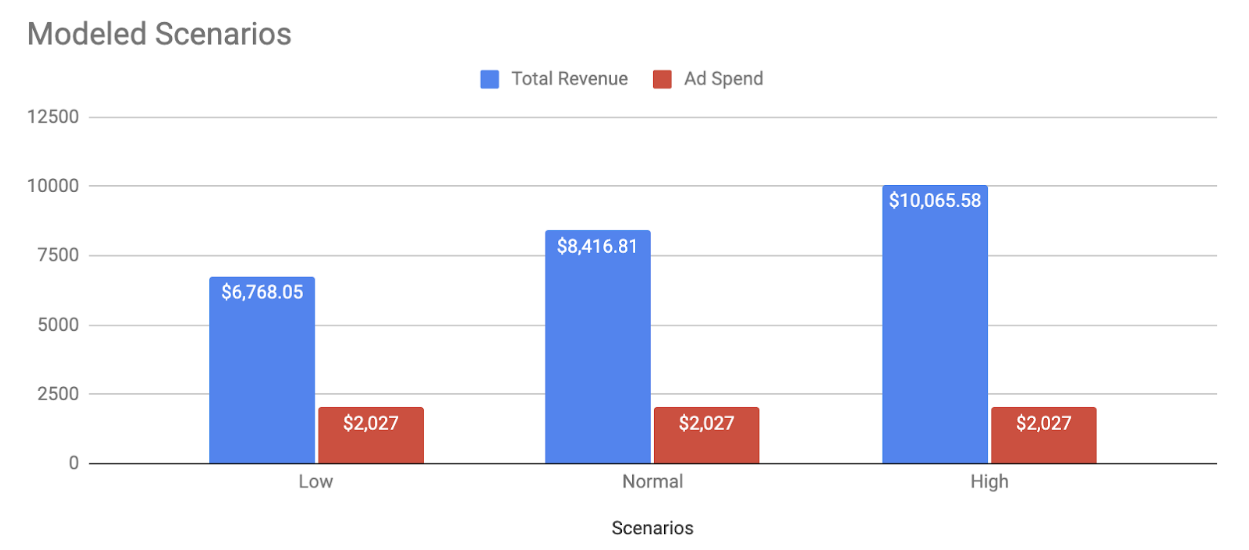
For Botany, all three scenarios looked extremely promising. We felt confident moving forward with the campaign. And our predictions rang true — Botany made $1,057,307 in crowdfunding revenue.
But what happens if your results don’t look great? You may wonder, “Why did I waste all this money on ads?”
That’s the wrong way to think about it. If you adopt a testing mindset, there’s no such thing as wasted ad spend. The dollars you “wasted” are dollars well spent understanding your positioning and audience.
Don’t be afraid to spend money, and don’t be afraid to be wrong. If your current strategy isn’t working, it’s better to find out now rather than months, and thousands of dollars, down the line.
Game design
It’s worth considering professional services for game design. A game consultant can help with:
- Brainstorming creative ideas
- Checking math, probability, and balance
- Developing game mechanics
- Designing UI/UX
- Writing your rulebook
Costs vary significantly depending on the consultant and scope of work, so ask around for rates. Consultancies usually run from $600-2500.
Intellectual property
To protect your intellectual property (IP), consider registering a copyright or trademark.
A copyright is a stamp of authorship for artistic, dramatic, and literary content. For the most part, you’re not required to register a copyright. Copyrights are automatic; the moment you create an original work, you own the exclusive rights to use, copy, distribute, and profit from that work. However, you do need to register if you ever file a lawsuit for copyright infringement. Copyrights are relatively inexpensive — it costs $45 to file online through the U.S. Copyright Office.
A trademark protects any IP that distinguishes your brand from others. Your game name, slogan, and logo are all eligible for trademark protection. You can register at a state or federal level. State trademarks are quicker and simpler to get, and they grant limited protection within your state borders. Federal trademarks are a little more complicated, but they grant nationwide protection and supersede state trademarks. It costs $225 to $600 to register for a federal trademark through the U.S. Patent and Trademark Office (USPTO).
Development costs: Designing and validating
As you flesh out your game concept, your costs go towards turning an abstract idea into a tangible, playable product. You’ll need:
- Designers and photographers
- An initial prototype
- Playtesters
Hiring designers and photographers
Board games require artistic design and craftsmanship. You may need to outsource:
- Art directors
- Photographers
- Illustrators
- Graphic designers
- 3D sculptors
Pricing will vary depending on your artist and artistic vision. How detailed is your design? What is the art style — cartoon, pixel, watercolor, realism, vector? Are you purchasing exclusive rights? How skilled or established is your artist?
Jasper Burch, creator of Nut Hunt!, shared some of the numbers he was quoted for fully rendered landscape illustrations:
- Illustration from established professional artists costs at a minimum $50 an hour.
- Fully rendered, high detail illustration for a card can run between $250 to north of $1,000.
- A box cover can cost $2,000-$6,000.
Suzanne Helmigh broke down the industry standard rates for a TTRPG:
- Character/creature/spot illustration without backdrop: $100-300
- Props/items: $50-150
- Quarter-page/Half-page illustrations: $200-650
- Full page heroic illustrations: $500-1000
- Book cover art: $500-3000
- Dm/gm screen art: $500-2000
- World/location Maps: $50-500
Start researching artists and asking for quotes. Find your favorite games on BoardGameGeek and scroll through their artist credits. Browse social media sites like Instagram, TikTok, and Twitch for both up-and-coming and established artists. Check out ArtStation and DeviantArt — both are vibrant communities full of artists showcasing their work.
Validating the First Prototypes
Don’t shell out for an initial prototype. During playtesting, you can’t be afraid to ruthlessly and systemically tear apart your game. Imagine you paid for six beautiful character cards and then decided to axe two of the characters. Wouldn’t it suck that much more knowing your prototypes went to waste?
Keep your prototype simple and functional. You don’t need a glossy board or intricate miniatures for playtesting. A rough sketch on butcher paper and some borrowed Monopoly pieces may just do the trick.
Playtesting sessions
The biggest cost during playtesting is time. Creators spend months and years refining their game, testing and retesting their gameplay until it’s airtight.
Your first playtesters are super accessible and free — they’re your friends and family! Invite them over, observe how they play, and ask for feedback.
Gradually open your testing to wider and wider audiences. Tabletop gaming is a super vibrant, engaged community. Upload a “print and play” version of your game to your website, and share the link with your social media network. You can find volunteers on Facebook groups, Discord groups, Reddit, and BoardGameGeek who are more than happy to playtest your game. For $19.99, you can model your game on TableTop Simulator and invite people to playtest online.
Buzz costs: Marketing and pre-launch
The biggest mistake first-time crowdfunders make is failing to win the pre-launch. You can’t simply click “launch” on Kickstarter, cross your fingers, and hope for the best. Before you go live, you’re investing in buzz costs to generate interest for your campaign.
Social media
Use social media to generate traffic to your reservation funnel. We recommend allocating most of your ad budget to Meta advertising. In our experience, the return on investment (ROI) from Facebook and Instagram blow other platforms like YouTube and TikTok out of the water.
So how much should you spend on advertising? The short answer is, it depends. Some clients have spent over $80,000 on the pre-launch, and some have spent under $5,000. We recommend testing and scaling your best-performing ads over a 2-4 month pre-launch. Keep a close eye on these two metrics:
- Cost per reservation: The average cost to get a reservation. On Meta, you can track this metric as the “cost per purchase.”
- Cost per lead: The average cost to get one lead or email.
For example, we isolated our highest-performing ad for Botany and scaled our Facebook spend accordingly.
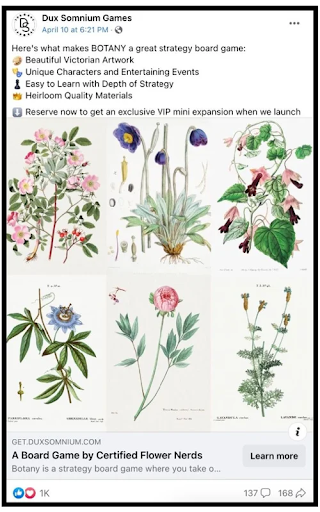
Here were our pre-launch metrics:
Ad spend: $12,511
Leads: 8,734
Cost per lead: $1.43
$1 reservations: 2,641
Cost per reservation: $4.74
The ads worked. We raised $105,965 in one day and $1,057,307 total. Needless to say, the client was happy with the return.
Finding the right crowdfunding platform
The two most prominent crowdfunding platforms for tabletop games are Kickstarter and Gamefound.
Kickstarter has raised $7.8 billion in pledges, with $2.3 billion in Games. Its lengthy track record includes titles like Frosthaven, Kingdom Death, and Avatar Legends. If you’re launching a tabletop roleplaying game, trading card game, party game, or heavily themed board game, you’re in good hands with Kickstarter.
Gamefound is an EU-based platform focused exclusively on tabletops and accessories; it’s raised €437,636,237 since launch. It boasts heavy hitters like Tainted Grail: Kings of Ruin, Castles of Burgundy: Special Edition, and Sleeping Gods: Distant Skies. Gamefound may have a slight edge over Kickstarter when it comes to Eurogames, story-driven games, and war games.
Build a Community
Community is absolutely vital in crowdfunding. The goal of a VIP list is to make a splash on launch day, get funded in the first 24 hours, and land on the front page of Gamefound or Kickstarter. For this to happen, your community needs to be active, excited, and engaged.
To nurture your community, create an exclusive, VIP-only group. Discord is particularly popular within the gaming community. Here’s the VIP Discord server we created for Alpha Clash.
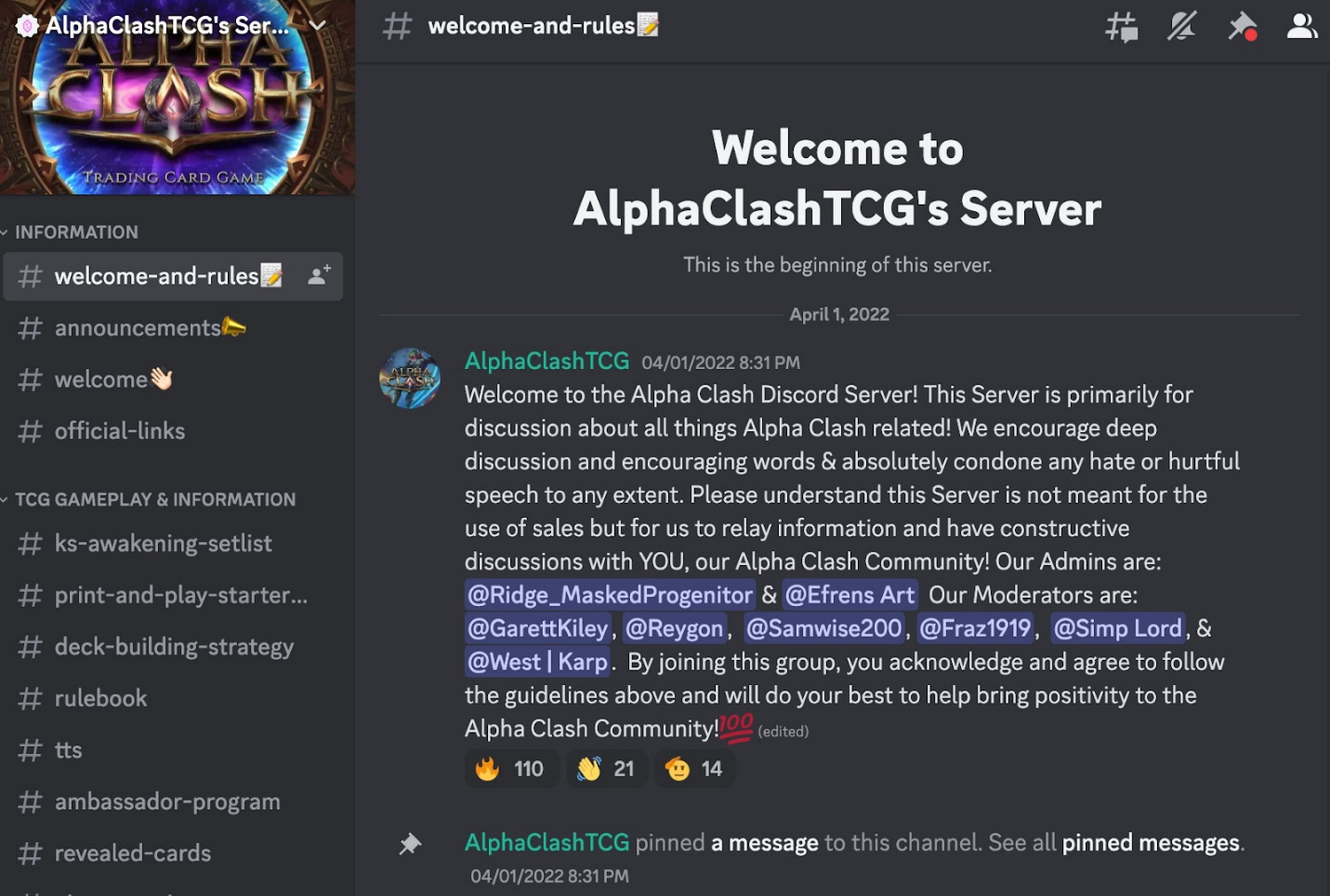
Use your Discord server to welcome new members to the group, provide updates, seek feedback, and celebrate milestones. This is your place to brag! Share the features that make your game special, innovative, and worth buying. For example, the founder Ridge Kiley created a YouTube video previewing the gameplay mechanics for Alpha Clash.
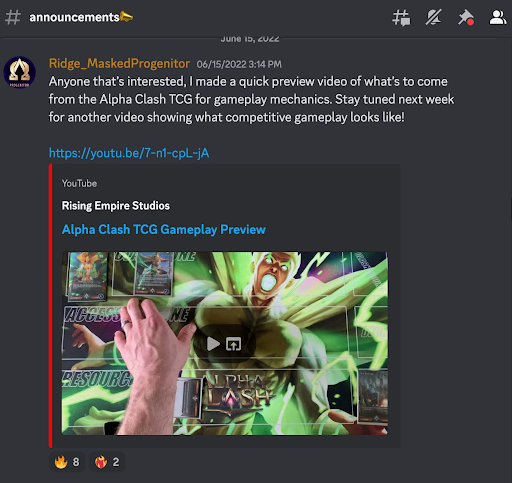
We also recommend engaging with the games community at large. An exhibitor booth at a games convention will cost around $1,000-3,000. To put your brand out there, you want to hit some of these major conventions:
Crowdfunding Costs: Raising Your Funds
When determining your funding goal, don’t forget to factor in crowdfunding and reward fees.
Fees
Pricing on Kickstarter and Gamefound are almost identical. Both charge a 5% fee on all successful campaigns and a payment processing fee of 3% + 0.20 in the project’s currency per pledge.
Both accept Stripe, PayPal, and Apple Pay as payment methods. Gamefound additionally partners with Adyen, which supports a wider range of payment methods compared to Stripe or PayPal. Adyen is definitely nice to have if you’re trying to reach a global audience or, particularly, a European audience.
Gamefound also gives backers the option to pay in monthly installments through StretchPay. If you have pricier add-ons and upsells, you may benefit from easing the financial burden for backers as much as possible.
Rewards
Many first-time crowdfunders forget to consider fulfillment costs in their funding goal and budget. They then get a rude awakening when it’s time to ship rewards.
We recommend budgeting 20% of your total product costs for reward fulfillment. Your total reward costs should encompass manufacturing, packaging, and shipping your product.
How LaunchBoom can help
The truth is, crowdfunding is hard. 59% of Kickstarter campaigns fail. We hear about the success stories, but not the millions of creators who see their dreams shattered.
We’ve helped thousands of entrepreneurs bring their ideas to life. Prior to working with us, many of them tried and failed to launch on their own. They sunk countless hours and dollars into the wrong places.
Our biggest advice on saving crowdfunding costs? Get it right the first time!
We’ve raised over $125 million in crowdfunding revenue for creators in 40 different countries. If you want to launch once and launch successfully, talk to an expert now.
Distribution costs: Shipping and logistics
Fulfillment is the process of getting your product to your backer’s address. It sounds simple, but if you’re not careful, the costs easily stack up. You should anticipate:
- Fulfillment costs
- Domestic and international shipping costs
- Taxes and unexpected costs
Fulfillment costs
When researching fulfillment centers, your cost projections should include:
- Initial set-up costs. Some fulfillment centers charge a one-time fee to start services for your company.
- Shipping and packaging expenses. Packaging fees include “pick and pack” fees. Shipping fees are calculated based on weight.
- Storage and warehousing fees. Some charge extra for heavy items or multiple SKUs (stock keeping units, pronounced “skews”).
- Return and replacement fees. Return charges may actually be higher than the original shipping charge, since the warehouse needs to receive the product and inspect for defects.
When calculating shipping expenses, there are two terms you need to know: deadweight and dimensional weight (DIM). Couriers measure both your package’s deadweight and dimensional weight and charge the higher of the two.
Deadweight is self-explanatory. It’s how much your package would weigh on a scale (e.g., three pounds). Dimensional weight is calculated by multiplying the length, width, and height of a package and dividing it by a cubic divisor, a number set by each carrier to calculate dimensional weight.
For example, let’s say your package is three pounds. Its dimensions are 24” × 12” × 12”. Let’s say you’re shipping through UPS, and their current cubic divisor is 139. To get the DIM weight, you would multiply 24” × 12” × 12”, then divide by 139 to get 25.
In this scenario, the courier will use your DIM weight, since it’s greater than your deadweight. Even though your package only weighs 3 pounds, it would be billed as if it weighed 25 pounds.
You can see that inefficient packaging quickly multiplies your costs. You want to keep your product safe, but you also want to steer clear of overly large packages. The smaller, the better!
Domestic and international shipping
Location greatly impacts shipping costs. Some countries are much more difficult to ship to.
For example, India requires more personal documentation from the receiver. If the receiver doesn’t provide this information, your package will be returned. Brazil imposes multiple taxes and duties on imports. Countries like Iceland and the Channel Islands are considered “remote areas”, where additional fees apply.
The same is true domestically. Shipping to Hawaii or Alaska is typically more costly than shipping with the continental United States.
Tax implications and unexpected costs
Taxes and duties vary per country, which makes it difficult to figure out your shipping budget. Easyship has a shipping calculator that details the exact amount of import taxes, VAT (value-added tax), GST (goods and services tax), and other fees for every country.
Be especially careful if your product has batteries. The last thing you want is to be waylaid at customs and hit with surprising fines. Certain batteries, such as lithium ion, stand-alone power packs, and disconnected batteries, are considered “dangerous goods” and can impose additional costs with couriers.
Final thoughts
Clearly, there are a lot of cost considerations in crowdfunding and publishing your board game. Self-publishing isn’t easy, but we can’t deny that it’s powerful. Crowdfunding makes it possible for unknown creators to launch a successful board game business and build a player base all over the world. Today, we discussed:
- How to create and sell a board game
- Budgeting for initial costs, buzz costs, crowdfunding costs, and distribution costs
- Choosing a crowdfunding platform for board games
How much does it cost to publish a board game: Frequently Asked Questions
How to get a board game published?
Here are the steps of how to get a board game published:
- Develop your initial game concept.
- Playtest your game to refine gameplay experience and mechanics.
- Market your game to generate interest with target audiences.
- Launch a crowdfunding campaign to raise funds and build a community.
- Partner with a reliable manufacturer to produce your game.
- Warehouse, package, and deliver your game to customers.
Can I publish a board game without any upfront costs?
It’s extremely difficult to publish a board game with no upfront costs whatsoever. In theory, crowdfunding seems like free money. It doesn’t cost anything to slap your product on Kickstarter. But you’re competing with thousands of live campaigns every day; without a solid pre-launch, it’s nearly impossible to stand out from the crowd. Before you launch, invest in researching and validating market demand, marketing your campaign, and testing and improving your product.
What happens if my crowdfunding campaign doesn’t reach its funding goal?
When a crowdfunding campaign doesn’t reach its funding goal, the most common mistakes we see are:
- Not positioning your product effectively
- Not investing enough in the prelaunch
- Not building a VIP community
If you fail, the most important thing you can do is analyze and learn from your mistakes. You now have a goldmine of information. Conduct a post-campaign analysis. Who engaged with your campaign? How closely did this match your expected audience? Where and when were people losing interest? From there, set the groundwork for a relaunch strategy.
How can I reduce the manufacturing costs of my board game?
To reduce manufacturing costs for your board game, choose a factory in a cost-effective location. In general, China is one of the cheapest and easiest places to manufacture. Chinese factories are vertically integrated, meaning they have the infrastructure to keep all production in-house.
However, you should also consider your specific manufacturing needs. Some countries are better suited for certain products. For example, the United States has excellent injection molding factories and assembly centers.




